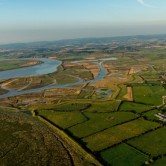
Monitoring the tide times could become more about planning their weekends and less about protecting their homes for the people in flood-prone areas of Somerset thanks to a new £20 million scheme.
People in the West Country county were among the worst hit during last year’s winter storms, but the creation of a new salt marsh aims to absorb waves and high tides to protect sea walls, land, homes, and businesses from erosion.
Sea water is now intentionally flooding the Steart peninsula, and it is thought the project will also create a valuable bird habitat.

250 hectare salt marsh protects communities and sea walls from erosion. Photograph: WWT
It is being supported by the Wildfowl & Wetlands Trust (WWT) and the Environment Agency (EA), but some critics believe the money should have been spent on more traditional flood defences instead.
Bridgwater and West Somerset MP Ian Liddell-Grainger has spoken out against the project, clearly believing that this will not be enough to prevent local people from checking tide times in trepidation as they prepare for their livelihoods to be lost in flood waters once again. He said the scheme would be more beneficial to birds than humans and called it ‘extravagant’ and ‘ridiculous’.
In contrast, the WWT and EA believe the coastal realignment that has taken place is the perfect way of combining forces with nature itself in a bid to fight off the effects of more violent, frequent winter storms, combined with rising sea levels.

Artist’s impression of the wildlife habitat that will be created by the £20 million project.
Martin Spray, the chief executive of the WWT, said the Steart Marshes project was a prime example of how wetland technology can be used to protect businesses and homes by working with nature rather than fighting against it.
The scheme, however, will only protect a small number of homes directly but also aims to ensure the safety of other sea defences, along with safeguarding the National Grid connection to the nearby Hinkley Point power station.
